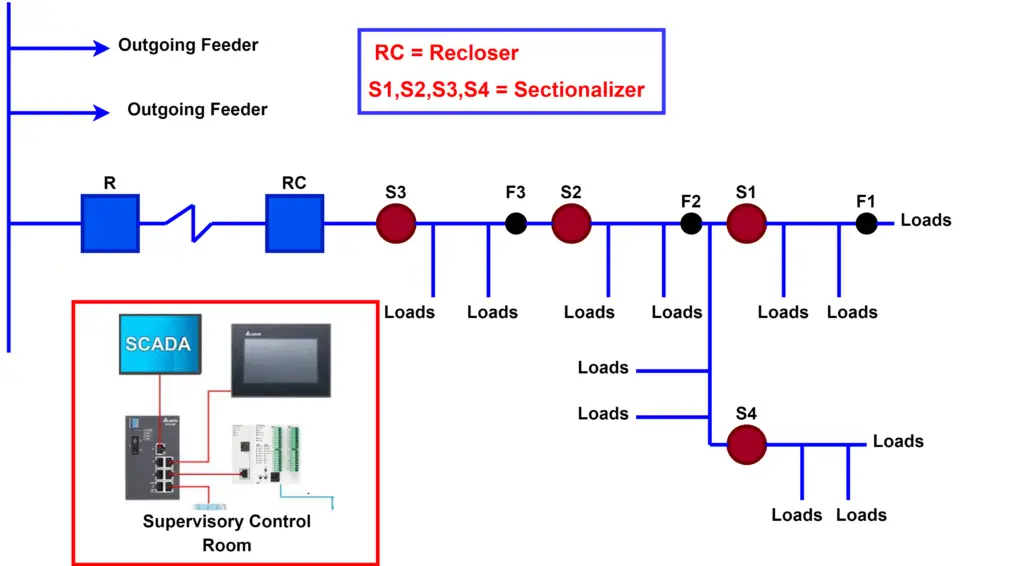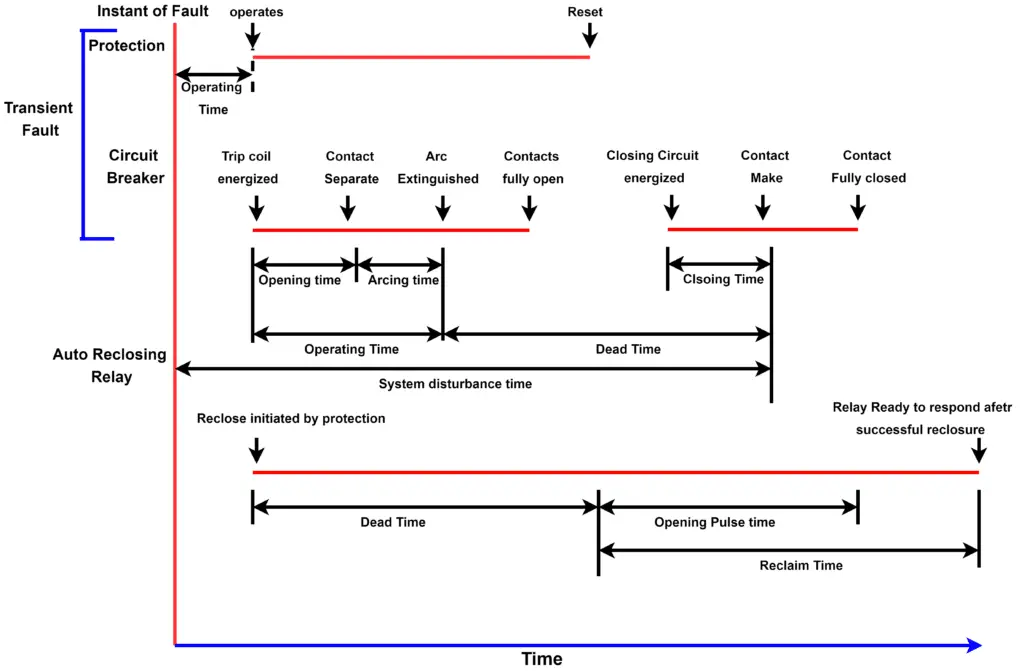What does Auto Reclosing mean in Power System?
Auto Reclosing scheme of transmission system refers to the automatic reclosing of breaker contacts soon after momentary isolation when a fault occurs in the system. The faults can be temporary or permanent. Practically, it has been found that about 70 to 80 % of the faults are of temporary nature and are of a short duration of time.
Auto Reclosing Systems are a series of connected networks that are used to mitigate operating cost and improves the reliability of the network. Usually, the EHV or Extra High Voltage transmission lines are used to transmit bulk amounts of electricity around several thousands of MW(Mega Watts) which should not get interrupted at any cost even when the faults on the overhead lines are natural.
Faults can be temporary or permanent. Temporary faults can be such as falling trees on the transmission lines, lightning, birds, etc., and which usually get cleared automatically without much Fault Rectification process. Permanent Faults can be such as broken conductors, or failure of insulators, which usually don’t get cleared in a short time. The lines don’t get restored in a short time, due to which in that time auto reclose does not help us.
Usually, during the manual operation or delayed operation, the operator resets the relays and closes the Circuit Breaker. But during a transient fault, the line holds after the second attempt of closing the circuit breaker, but if the fault is still in the line, the protection system again trips the circuit and can be declared a permanent fault. However, during the temporary fault, a significant delay occurs due to manual operation for the reclosing of the circuit.
Generally, any delayed operation causes a big loss of the transmission system in the view of cost and stability because the extra high voltage (EHV) carries a bulk amount of power. Therefore, to avoid such delayed operation (manual switching), the auto reclosing scheme in the EHV systems has been introduced to avoid unwanted delay due to human operation.

Reclosers divide up the network into smaller sections (sectionalized) and address these faults. The reclosers are programmed to automate the reset process and allow a rough approach to service restoration. Thus, it results in increased availability of supply.
The main purpose of the Auto Reclosing system is as below:
- Improved supply continuity
- To reduce the supply interruptions to the consumer.
- Reduction of substation visits.
The recovery time of the Transient Fault and Semi-Permanent Fault can be reduced by Auto-Recloser or reclosing scheme. Auto Reclosing scheme consists of high-speed operating contacts with Solid Dielectric Insulation with vacuum interrupters for the current interruption, arc quenching, and advanced current and voltage sensing devices. Usually in the auto reclosing scheme if the fault is not cleared at the first attempt, there will be a double or triple shot of reclosing until the fault if cleared. If the fault persists, this scheme permanently opens the CB.
Types of Auto Reclosing Techniques
Single-Shot Auto-Reclosing
It refers to the auto-reclosing of a CB, only once. As soon as possible the reclosure is made so that no drift occurs in the phase angle between the voltages at the two ends of the open line.
Usually employed in the case of EHV Transmission lines where there is the possibility of either temporary or permanent but not semi-permanent faults.
Multi-Shot Auto-Reclosing
Multi-Shot auto reclosing refers to the auto-reclosing of a CB more than once within a predetermined reclosing sequence. This reclosing can be provided up to 3 times. As soon as possible the first reclosure is provided. If the supply is not restored then second and third reclosures are provided after a few seconds and 1 or 2 minutes respectively. If still fault persists, then it’s declared a permanent fault for which further reclosure will be provided manually only after detection and repair by the staff.
This type of auto-reclosing is employed with the lines where semi-permanent faults can occur i.e., for lines with voltages <= 33kV. Because semi-permanent faults can be cleared only after 2 or 3 reclosures.

Factors affecting Auto Reclosing Scheme
The factors mostly influence the choice of dead time, reclaim time, and the number of shots. Several factors affect the selection of system dead time as follows:
- System Stability and synchronism
- CB Characteristics
- Type of Load
- Fault path de-ionization time.
- Protection reset time.
Usually, it is not required to check synchronism for rapid reclosing type while for delayed reclosing synchronism should be checked before reclosing. For this purpose, synchronous relays are employed.